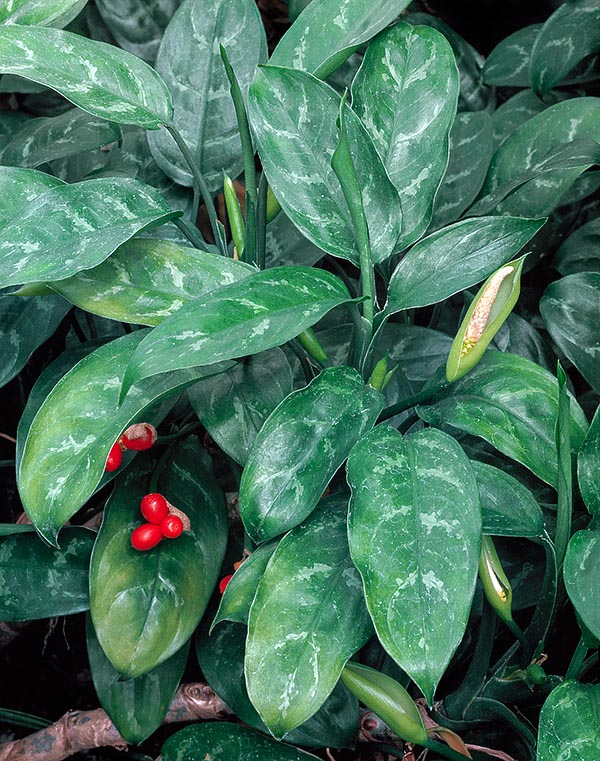Family : Araceae

Text © Pietro Puccio

English translation by Mario Beltramini

Aglaonema commutatum with flowers and fruit. Tropical but easy to grow indoor © Giuseppe Mazza
The Aglaonema commutatum Schott (1856) is native to the humid forests of Sulawesi and Philippines.
The name of the genus is the combination of the Greek words “aglaos” = shining and “néma” = thread, with reference to the bright stamens of the flowers; the Latin name of the species, “commutatum” = changed, altered, refers to the leaves variegation.
Common names: “Chinese evergreen”, “Philippine evergreen” (English); “café-de-salão” (Portuguese); “Aglaoneme”, “Kolbenfaden” (German).
Evergreen, perennial, herbaceous presenting erect stamens, often tufted and ramified at times, 0,5-1,5 m tall and with a diameter of 1-6 cm, which tend to become creepy with the age, 5-25 cm long petioles and elliptic-lanceolate leathery leaves, 12-30 cm long and 6-12 cm broad, sharp at the apex, of a dark green colour, with silvery-grey variegations along the main lateral venations.
The axillar inflorescences, from one to six, are formed by a 3-6 cm long cream white spadix with the male flowers occupying the upper part for about 2-5 cm, and the female ones the remainder, surrounded by a 4-9 cm long, greenish spathe; the fruits are ovoid berries, about 1,5-2,5 cm long, initially green, then yellow and finally bright red when ripe, containing one seed only.
It reproduces by seed, division and cutting, and by portions of stem which root also in water.
The plant can be utilized in open zones in the tropical and humid subtropical areas in shaded positions, on draining organic substrata, as edge or to cover the soil, ideal for giving liveliness to particularly shady spaces; elsewhere, it is cultivated in pot for indoor decoration and is one of the most spread of the genus, due to its greatly ornamental foliage, the moderate tallness, the facility of cultivation and its adaptability to poorly luminous or scarcely ventilated locations.
The substratum must be organic, with addition of sand and of agri perlite, porous and well drained, in order to avoid radical rottenness. The temperature must be kept over 15-16°C, best around 20-22°C, without sudden variations. During the vegetative period, watering must be moderate and the substratum is to be kept just humid, during winter, they are to be reduced, letting the substratum to dry up almost completely between the various watering.
All parts of the plant contain toxic substances, in particular calcium oxalate, which can cause contact dermatitis and even serious reactions, if chewed and ingested.
Synonyms: Aglaonema marantifolium var. commutatum (Schott) Engl. (1879).
